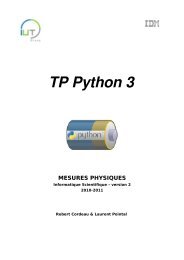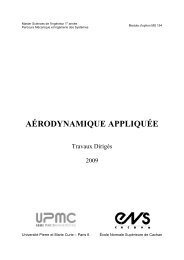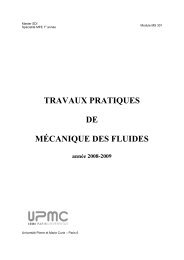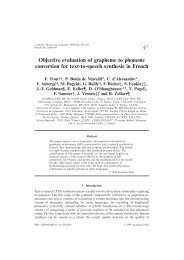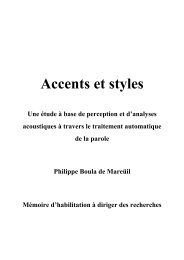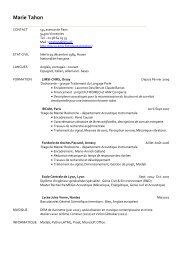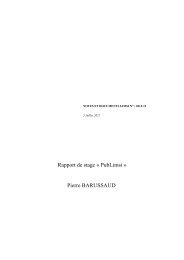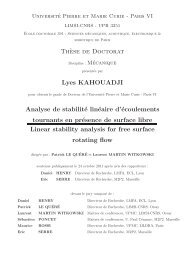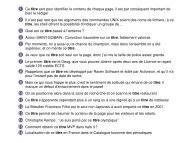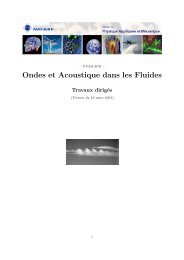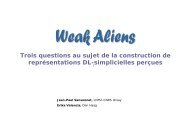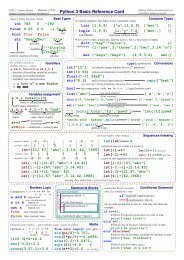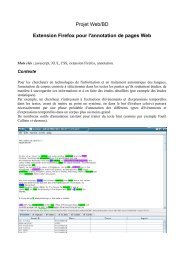Improving Rocchio with unsupervised clustering - limsi
Improving Rocchio with unsupervised clustering - limsi
Improving Rocchio with unsupervised clustering - limsi
Create successful ePaper yourself
Turn your PDF publications into a flip-book with our unique Google optimized e-Paper software.
<strong>Improving</strong> <strong>Rocchio</strong> <strong>with</strong> <strong>unsupervised</strong> <strong>clustering</strong><br />
Romain Vinot romain.vinot@enst.fr<br />
François Yvon francois.yvon@enst.fr<br />
GET/ENST, 46 rue Barrault, 75634 Paris Cedex, France<br />
Abstract<br />
This paper presents a novel approach for<br />
adapting the complexity of a text categorization<br />
system to the difficulty of the task.<br />
In this study, we adapt a simple text classifier<br />
(<strong>Rocchio</strong>), using <strong>unsupervised</strong> <strong>clustering</strong><br />
techniques. The idea is to identify sub-topics<br />
of the original classes which can help improve<br />
the categorization process. To this end, we<br />
propose several <strong>clustering</strong> algorithms, and report<br />
results of various evaluations on standard<br />
benchmark corpora such as the Newsgroups<br />
corpus.<br />
1. Introduction<br />
The automated categorization of documents (Sebastiani,<br />
1999) into predefined categories has progressively<br />
emerged as one of the most popular task in the<br />
area of Text Mining technologies. The categorization<br />
paradigm provides a very general framework for many<br />
practical applications such as filtering, routing, indexation,<br />
tracking.... Historically, research in automated<br />
text categorization has been promoted by the Information<br />
Retrieval community, in the context of automated<br />
text indexation. In the past five to ten years, this task<br />
has been rediscovered by the Machine Learning community<br />
and has since been the subject of many empirical<br />
studies (Yang, 1997), demonstrating the applicability<br />
and efficiency of Machine Learning algorithms<br />
such as Support Vector Machines (Joachims, 1998) and<br />
Boosting techniques (Schapire & Singer, 2000).<br />
The <strong>Rocchio</strong> algorithm (<strong>Rocchio</strong>, 1971), originally proposed<br />
as a means to improve information retrieval (IR)<br />
systems, is conceptually one of the simplest text categorization<br />
algorithm. As such, it has been shown to be,<br />
in many experimental conditions, less successful than<br />
other approaches, such as SVMs or k-NN. Various improvements<br />
of this algorithm have been proposed, eg.<br />
in (Singhal et al., 1997) or (Buckley & Salton, 1995),<br />
which have been successfull in effectively increasing<br />
the performance of this methodology.<br />
As discussed for instance in (Vinot & Yvon, 2001),<br />
<strong>Rocchio</strong> is especially well suited for applications where<br />
(i) the number of classes is high; (ii) the n-best answers<br />
(rather than just the first one) are taken into account<br />
and (iii) class labels are noisy. This seems to happen in<br />
practical applications, especially when categories cannot<br />
be directly linked <strong>with</strong> the thematic content of documents.<br />
Conversely, we have experimentally demonstrated<br />
that classes <strong>with</strong> heterogeneous content can<br />
badly impair its performance. This behaviour is consistent<br />
<strong>with</strong> the simplicity of the underlying statistical<br />
model and of the learning procedure.<br />
In this paper, we investigate several procedures allowing<br />
<strong>Rocchio</strong> to automatically adapt its complexity to<br />
the data, in an <strong>unsupervised</strong> way. The idea is to identify<br />
useful subclasses in the training data, and to use<br />
these to refine the decision surface; each new subclass<br />
increasing the overall model complexity. The main<br />
novelty of this work lies in our attempt to discover<br />
these subclasses in such a way that the resulting partition<br />
actually improves the resulting decision rule.<br />
The idea of using <strong>unsupervised</strong> <strong>clustering</strong> to improve<br />
supervised classification is not entirely new, and has<br />
already been suggested in several contexts. In the<br />
context of the k-nearest neighbors algorithm, many<br />
authors have advocated <strong>unsupervised</strong> <strong>clustering</strong> as a<br />
means to organise very large instance sets, thus speeding<br />
up the k-nn computation .<br />
In the context of the (TREC) batch filtering task,<br />
(Eichmann et al., 1999) and (Oh et al., 2001) incrementally<br />
cluster the incoming data into subclasses of<br />
the original classes. These clusters are then used as<br />
(new) regular class label, and serve to classify the new<br />
data: any document falling into cluster S of class C<br />
is eventually labelled as C. While both papers use
ather different classification algorithms (Rochhio for<br />
the former paper, and SVM for the latter), both report<br />
quite unconclusive results. In any case, this optimisation<br />
does not seem to increase overall performance.<br />
One should note that in this approach, <strong>clustering</strong> and<br />
classification are viewed as two separate and unrelated<br />
processes.<br />
(de Kroon et al., 1996)’s motivations for using <strong>unsupervised</strong><br />
<strong>clustering</strong> are clearer: these authors explicitely<br />
aim at structuring an heterogeneous corpus<br />
of training texts, in the context of a filterning task.<br />
Relevant texts are first partitionned into N clusters,<br />
using autoclass (?). Test documents are then classified<br />
as follows: for each subclass a relevance judgement is<br />
separately computed; these judgements are then linearly<br />
combined, using a perceptron. This procedure<br />
seems to provide the authors an effective means to<br />
isolate those clusters which provide the most relevant<br />
judgements.<br />
(Lam, 1998)’s idea is to use <strong>clustering</strong> techniques in<br />
order to make the k-nn decision rule less sensible to<br />
noisy data, and more like a linear classifier. Proceeding<br />
bottom-up, their algorithm recursively aggregates<br />
training instances subject to the condition that (i) they<br />
belong to the same class and (ii) they are sufficiently<br />
close in the representational space. Test documents<br />
are then classified according to the following two-steps<br />
procedure: first compute the similarity <strong>with</strong> each cluster<br />
using <strong>Rocchio</strong> or the Widrow-Hoff rule; then linearly<br />
combine these similarities to compute the final<br />
label. This procedure provides a significant improvement<br />
both over a “pure” k-nn approach and a “pure”<br />
linear decision.<br />
This paper is organised as follows: in Section 2 we<br />
present the Rochhio algorithm and discuss its main<br />
advantages and drawnbacks. Section 3 explains how<br />
this baseline is completed <strong>with</strong> an <strong>unsupervised</strong> <strong>clustering</strong><br />
procedure. We describe two algorithms which<br />
aim at creating those clusters that might prove beneficial<br />
for the classification procedure. Section 4 reports<br />
and discusses experimental results obtained on 3 different<br />
textual databases and Section 5 present some<br />
conclusions and directions for future work.<br />
2. <strong>Rocchio</strong><br />
<strong>Rocchio</strong> is a text classifier originally introduced in<br />
(<strong>Rocchio</strong>, 1971) to improve information retrieval systems<br />
<strong>with</strong> relevance feedback. It uses the vector space<br />
model (Salton et al., 1975): every text d is represented<br />
by a vector [d] in R n (<strong>with</strong> n the number of distinct<br />
word in the corpus), each coordinate dw can be com-<br />
puted from the frequency fr(w, d) of word w in d as :<br />
dw = T F IDF (w, d) = log(1 + fr(w, d)) ∗ log( N<br />
N(w) )<br />
(1)<br />
where N is the number of documents in the corpus<br />
and N(w) the number of documents in which w occurs<br />
at least once. This measures emphasizes those<br />
words which simultaneously occur frequently in the<br />
document while occuring only in a few documents.<br />
Each vector [d] is then normalized according to: dw =<br />
dw in [d] so as to lessen the weight of longer<br />
w d2 w<br />
documents. A prototypical profile [c] is computed for<br />
each class c according to :<br />
cw = t<br />
<br />
dw −<br />
Nc<br />
d∈c<br />
1 − t <br />
Nc<br />
d∈c<br />
dw<br />
(2)<br />
<strong>with</strong> Nc the number of documents in c, Nc the number<br />
of documents not in c and t a free parameter between<br />
0 and 1 . These profiles are defined as the centroid of<br />
the examples (<strong>with</strong> a positive coefficient for examples<br />
in the class and a negative one for the others). These<br />
vectors are also normalized. In the context of a routing<br />
task, one usually chooses t = 1 (in this case, negative<br />
examples do not contribute to the centroids).<br />
Classification of new documents are performed by<br />
computing euclidian distance between the document<br />
vector and the prototype vector of each class; the document<br />
is then assigned to the nearest class. As all<br />
vectors (prototypes and documents) are normalized,<br />
euclidian distance is equivalent to cosine similarity or<br />
dot product which is then used for implementation reasons.<br />
In the context of this paper, <strong>Rocchio</strong> presents two important<br />
characteristics :<br />
• The decision rule computed by <strong>Rocchio</strong> is a linear<br />
separator (hyperplane) in the vector space. It<br />
gives <strong>Rocchio</strong> the same expressiveness as a Perceptron<br />
classifier. As (?) shows on filtering tasks,<br />
accuracy of <strong>Rocchio</strong> <strong>with</strong> dynamic feedback are<br />
comparable to that of a neural network trained<br />
<strong>with</strong> a gradient descent algorithm.<br />
• The learning model of <strong>Rocchio</strong> is a generative<br />
one. Parameters are optimized to match the data,<br />
not to discriminate the different classes. Generative<br />
models usually have lower asymptotic performance<br />
value than discriminative ones, but they<br />
converge to their optimal performance faster, especially<br />
when there is lots of parameters to esti-
mate (which is the case in the textual classification<br />
domain) (?).<br />
We have shown in (Vinot & Yvon, 2002) that <strong>Rocchio</strong><br />
is robust in the presence of noise and very effective<br />
for routing task <strong>with</strong> a high number of classes.<br />
On the other hand, its inability to take into account<br />
the substructure of classes (such as different<br />
subtopics) is a significant drawback compared to others<br />
algorithms. <strong>Rocchio</strong> vastly underperforms other<br />
algorithms when classes contain intermixed subtopics:<br />
when some subtopics of different classes are nearer<br />
than subtopics of the same class (for example in the<br />
case of spam filtering, the subtopic on software advertisement<br />
can be closer to legitimate emails than<br />
to other subtopics of spams such as ones <strong>with</strong> pornographic<br />
content). In the remainder of this paper, we<br />
will call classes <strong>with</strong> such intermixed subtopics “heterogeneous<br />
classes”. Figure 1 shows an example of homogeneous<br />
and heterogeneous classes in terms of relative<br />
positioning of subtopics in the vector space.<br />
Homogeneous classes Heterogeneous classes<br />
Figure 1. Homogeneous and heterogeneous corpus (round<br />
and square classes have two subtopics).<br />
These difficulties in dealing <strong>with</strong> classes <strong>with</strong> intermixed<br />
subtopics come from the generative model used<br />
by <strong>Rocchio</strong>. It assumes that each class has a spherical<br />
shape and that the information of the centroid<br />
is enough to describe correctly a class. Training is<br />
accordingly straightforward, because one only has to<br />
compute the centroid of all examples for each class.<br />
But in the case where this model doesn’t suit the corpus,<br />
<strong>Rocchio</strong> will perform poorly.<br />
To avoid these shortcomings, one need to allow <strong>Rocchio</strong><br />
to use more complex models while at the same<br />
time preserving its simple learning process. This can<br />
be achieved <strong>with</strong> the use of a <strong>clustering</strong> algorithm<br />
which will split the classes into coherent sub-classes.<br />
A prototype is then computed for each cluster, as if<br />
it was a class in its own right. New examples are labelled<br />
according to the class of the nearest prototype.<br />
We call this class of algorithms Multi-Prototypes <strong>Rocchio</strong><br />
(MPR).<br />
<strong>Rocchio</strong> can be seen as a neural network <strong>with</strong> no<br />
hidden layer. Weights are not learned by a backpropagation<br />
algorithm but simply computed as the<br />
mean of weights of all examples. Clusters are analog<br />
to a hidden layer having as many neurons as clusters.<br />
Weights of connection between initial layer and hidden<br />
layer are still computed by the mean of examples,<br />
weights between the hidden layer and the final layer<br />
are binary values according to the class of the cluster.<br />
Propagation of weights are different in MPR, because<br />
classification is based on the nearest prototype (the<br />
hidden neuron <strong>with</strong> the highest weight) instead of a<br />
weighted sum of all hidden layers. With this analogy,<br />
we see that the <strong>clustering</strong> allows to change the complexity<br />
of the underlying model.<br />
Moreover, preliminary experiments (Vinot & Yvon,<br />
2002) show that the use of subclasses can be very useful<br />
for heterogeneous classes but not for homogeneous<br />
ones. The model complexity (in other words number of<br />
clusters) must not be chosen according to the data but<br />
driven by the accuracy of <strong>Rocchio</strong>. There is no need<br />
to separate two subtopics of the same class if they are<br />
not mixed <strong>with</strong> any subtopic of another class. This<br />
suggests that <strong>clustering</strong> must be performed using a<br />
discriminative approach rather than a generative one.<br />
Most of the <strong>clustering</strong> algorithms described in introduction<br />
don’t meet these requirements, because the<br />
<strong>clustering</strong> process is independent of the categorization<br />
one. They don’t try to directly optimize the accuracy<br />
of the induced classifier (<strong>with</strong> the exception of the GIS<br />
algorithm from Lam).<br />
3. Clustering algorithms<br />
We want to devise a <strong>clustering</strong> algorithm which detects<br />
clusters in heterogeneous classes but not those in homogeneous<br />
classes. This condition can be translated<br />
as a mathematical criterion in various ways. We have<br />
explored two different criteria: the first one is based on<br />
the relative positioning of clusters, the second one is<br />
more directly error-driven and based on example categorization.<br />
Both are integrated into a top-down hierarchical<br />
<strong>clustering</strong> (at each step, we split one cluster<br />
into two new smaller clusters).<br />
3.1. Notations<br />
Let C = {c1, ..., ck} be a set of k classes, N the number<br />
of examples and Π = {Π1, ..., Πp} the unknown<br />
partition of examples. c(x) is the class of example x<br />
and c(Πi) the class labels of the examples in Πi. Clusters<br />
are only allowed to split the existing classes. The<br />
partition must then verify:
∀(x, y) Π(x) = Π(y) ⇒ c(x) = c(y) (3)<br />
3.2. Top-down <strong>clustering</strong><br />
Our algorithm starts <strong>with</strong> one cluster per class. At<br />
each step, we want to split the cluster <strong>with</strong> the largest<br />
dispersion of its documents. As explained in (Han &<br />
Karypis, 2000), the norm is the square-root of the average<br />
pairwise similarity between the documents:<br />
||c|| 2 = <br />
= 1<br />
N 2 c<br />
= 1<br />
N 2 c<br />
<br />
w d∈c dw<br />
2 w d1,d2∈c d1wd2w<br />
<br />
<br />
d1,d2∈c [d1][d2]<br />
w c2w = 1<br />
N 2 c<br />
(4)<br />
So we choose the cluster <strong>with</strong> the smallest norm and<br />
apply any <strong>clustering</strong> algorithm to create two subclusters.<br />
We choose K-Means for its simplicity. The split<br />
is tested according to the wanted criterion. If the division<br />
is not accepted, we try <strong>with</strong> the cluster <strong>with</strong> the<br />
second smallest norm and so on until no more splitting<br />
is accepted.<br />
Algorithm 1 Top-down <strong>clustering</strong> <strong>with</strong> criterion<br />
Parameter: A criterion Cri<br />
Π initial partition <strong>with</strong> one cluster per class.<br />
S = ∅<br />
while S = Π do<br />
p = argmax p∈Π−S(||p||)<br />
Apply 2-means on p. Let p1 and p2 be the two<br />
clusters.<br />
if Cri is verified then {Division is accepted}<br />
Π = Π − p + p1 + p2<br />
S = ∅<br />
else<br />
S = S + p<br />
end if<br />
end while<br />
3.3. Criterion RP : <strong>with</strong> relative positioning of<br />
clusters<br />
∀i, j<br />
c(Πi)<br />
<br />
= c(Πj) ⇒ ∃k, c(Πk) = c(Πi)<br />
d(Πi, Πk) ≤ d(Πi, Πj)<br />
and<br />
d(Πj, Πk) ≤ d(Πi, Πj)<br />
(5)<br />
This constraint means that for each pair of clusters of<br />
the same class, there must exist a third cluster of another<br />
class between the two (see figure 2 for a small illustration).<br />
This constraint is obviously satisfied <strong>with</strong><br />
one cluster per class. The criterion is then to maximize<br />
the number of clusters while keeping the constraint<br />
satisfied.<br />
0000000<br />
1111111<br />
0000000<br />
1111111<br />
0000000<br />
1111111<br />
0000000<br />
1111111<br />
0000000<br />
1111111<br />
0000000<br />
1111111<br />
0000000<br />
1111111<br />
0000000<br />
1111111 000 111<br />
0000000<br />
1111111 000 111<br />
0000000<br />
1111111 000 111<br />
0000000<br />
1111111 000 111<br />
0000000<br />
1111111 000 111<br />
0000000<br />
1111111<br />
0000000<br />
1111111<br />
0000000<br />
1111111<br />
0000000<br />
1111111<br />
0000000<br />
1111111<br />
0000000<br />
1111111<br />
0000000<br />
1111111<br />
0000000<br />
1111111<br />
Figure 2. Illustration of the “zone between two clusters”.<br />
At each step of the full <strong>clustering</strong> process, we only test<br />
if the two newly constructed clusters verify our criterion.<br />
The global constraint is not garanteed because<br />
we do not verify it for all the other pairs of clusters.<br />
An additional threshold controls the clusters size preventing<br />
the building of too small solutions, which are<br />
often noisy and unreliable : clusters are never accepted<br />
if they contain less than N0 examples. If we don’t<br />
use this filtering, the algorithm will create noisy clusters<br />
<strong>with</strong> very few examples. Then, these clusters will<br />
“help” other division to be accepted. In our experiments,<br />
we see that <strong>with</strong>out filtering, the algorithm<br />
continues very long and finishes <strong>with</strong> lots of very little<br />
clusters which is not what we want. We have chosen<br />
N0 = 20 for all our experiments.<br />
3.4. Criterion DC: <strong>with</strong> training documents<br />
categorization<br />
Min<br />
<br />
<br />
<br />
x|∃Π1, Π2 s.t.<br />
<br />
c(Π1) = c(Π2) = c(x) <br />
Π1, Π2 nearest clusters of x<br />
(6)<br />
This formula expresses the fact that we want to minimize<br />
the number of examples for which the two nearest<br />
prototypes are in the same class. Ihe idea is that if this<br />
is true for a lots of examples, then we don’t need to distinguish<br />
those two prototypes. As before, this formula<br />
is obviously minimal <strong>with</strong> one cluster per class. Whenever<br />
a second cluster is created for any class, there is<br />
almost always at least one example which doesn’t satisfy<br />
the criterion anymore. We need to relax our formula<br />
to allow the creation of some clusters even if few<br />
examples don’t satisfy the criterion. So clusters are<br />
accepted even though the formula is not minimized<br />
according to the relative number of non satisfied examples<br />
and total number of examples in clusters. New<br />
clusters are selected if less than m ∗ min(|p1|, |p2|) examples<br />
of the two clusters don’t satisfy the constraint<br />
anymore, <strong>with</strong> m a free parameter. Experiments show<br />
that results are not very sensitive to the value of m.
Finally, we also need to point out that only correctly<br />
classified examples are taken into account in this criterion,<br />
which implicitely lowers the influence of noisy<br />
examples. With this caracteristic, there is no need to<br />
filter small clusters, filtering being already implicitely<br />
performed by the criterion.<br />
4. Experiments and results<br />
4.1. Corpora<br />
We have used three different corpora: Newsgroups,<br />
Spam and Mail Center.<br />
The Newsgroups corpus contains 20000 messages,<br />
evenly distributed in 20 classes, each class corresponding<br />
to a different Usenet newsgroup. A list of Newsgroups<br />
is given in table 1. Two new corpora were<br />
then derived: the first one is obtained by merging<br />
newsgroups <strong>with</strong> the same Usenet prefix 1 , leading to<br />
a partition of messages into 4 homogeneous classes;<br />
the second one results from the merging of unrelated<br />
newsgroups into four super-classes, so as to have intermixed<br />
subclusters. This corpus is later referred to<br />
as the heterogeneous corpus.<br />
The Spam corpus contains 2193 emails. The task is<br />
here to discriminate junk or unsollicited emails from<br />
the legitimate ones. The corpus contains 1460 spams<br />
for 733 legitimate emails. Messages in English and in<br />
French are mixed in the two classes.<br />
The Mail Center corpus contains 2393 emails received<br />
by a customer service classified in 40 categories (see<br />
(Vinot & Yvon, 2001) for more information regarding<br />
this corpus). Almost all messages are written in<br />
French.<br />
In all our experiments, two third of the corpus is used<br />
for training and the remaining part is used for testing.<br />
4.2. Accuracy measures<br />
Experiments have been performed for all corpora <strong>with</strong><br />
the following algorithms: K nearest neighbors, Support<br />
Vector Machine, simple <strong>Rocchio</strong>, Clustered-SVM,<br />
MPR <strong>with</strong> K-Means, criterion-based <strong>clustering</strong> and<br />
a greedy division <strong>clustering</strong>. The greedy <strong>clustering</strong><br />
always splits the cluster <strong>with</strong> the smallest norm.<br />
Clustered-SVM is similar to the work of (Oh et al.,<br />
2001): after <strong>clustering</strong>, a SVM is learned for each cluster<br />
and new documents are assigned to the class of<br />
the best cluster. For algorithms where the number of<br />
1 We have placed soc.religion.christian, alt.atheism and<br />
misc.forsale in the most similar classes so as to have superclasses<br />
<strong>with</strong> homogeneous sizes.<br />
1. comp.graphics 11. alt.atheism<br />
2. comp.windows.x 12. sci.electronics<br />
3. comp-os.ms-windows.misc 13. sci.crypt<br />
4. comp.sys.mac.hardware 14. sci.space<br />
5. comp.sys.ibm.pc.hardware 15. sci.med<br />
6. talk.politics.guns 16. misc.forsale<br />
7. talk.politics.mideast 17. rec.sport.baseball<br />
8. talk.politics.misc 18. rec.sport.hockey<br />
9. talk.religion.misc 19. rec.autos<br />
10. soc.religion.christian 20. rec.motorcycles<br />
Base 1 Base 2<br />
Non mixed subclusters Intermixed subclusters<br />
C1 : 1,2,3,4,5 C1 : 1,2,6,12,16<br />
C2 : 6,7,8,9,10,11 C2 : 3,7,8,13,17<br />
C3 : 12,13,14,15 C3 : 4,9,10,14,18<br />
C4 : 16,17,18,19,20 C4 : 5,11,15,19,20<br />
Table 1. List of groups for the newsgroups corpus.<br />
clusters must be provided (such as K-Means), we use<br />
the number found by criterion-based <strong>clustering</strong>. To<br />
compare the algorithms, we use a more general performance<br />
measure than usual accuracy. AccN is defined<br />
as the pourcentage of testing examples for which the<br />
correct class is found in one of the n-best answers of the<br />
algorithm. This measure seems to provide a reasonable<br />
estimate of actual performance in applicative contexts<br />
involving a human validation (Vinot & Yvon, 2001).<br />
We have shown in (Vinot & Yvon, 2002) that <strong>Rocchio</strong><br />
performs comparatively much better <strong>with</strong> AccN<br />
(N > 1) than <strong>with</strong> Acc1.<br />
Results presented in table 2 suggest the following comments:<br />
• SVM constantly outperforms all other algoithms<br />
for the Acc1 measure.<br />
• Clustered-SVM is always lower than simple SVM,<br />
as in (Oh et al., 2001).<br />
• For the three newsgroups corpora, MPR is only<br />
slightly better than <strong>Rocchio</strong> and always worst<br />
than k-NN or SVM.<br />
• For Spam and Mail Center databases, the improvement<br />
over <strong>Rocchio</strong> is very sensible and MPR<br />
surpasses k-NN and even SVM for Mail Center<br />
<strong>with</strong> Acc2.<br />
• MPR improves <strong>Rocchio</strong> more for Acc1 than for<br />
Acc2.<br />
• The different <strong>clustering</strong> algorithms have a very<br />
similar behaviour. The main advantage of our
Newsgroups Spam Mail<br />
normal heterogeneous homogeneous Center<br />
<strong>Rocchio</strong> 0.810/0.921 0.754/0.921 0.892/0.973 0.771/. 0.508/0.724<br />
K-NN 0.844/0.944 0.864/0.970 0.932/0.983 0.930/. 0.535/0.649<br />
SVM 0.865/0.932 0.890/0.968 0.959/0.990 0.974/. 0.578/0.713<br />
clustered-SVM .. 0.878/0.960 0.940/0.984 0.978/. 0.532/0.698<br />
K-Means 0.810/0.921 0.815/0.944 0.904/0.973 0.959/. 0.527/0.726<br />
Greedy <strong>clustering</strong> 0.809/0.921 0.804/0.943 0.908/0.975 0.948/. 0.560/0.729<br />
Criterion RP 0.813/0.924 0.818/0.942 0.905/0.972 0.964/. 0.522/0.723<br />
Criterion DC 0.818/0.922 0.813/0.932 0.907/0.973 0.962/. 0.562/0.731<br />
criterion-based <strong>clustering</strong> is its ability to automatically<br />
determine the “right” number of clusters.<br />
Overall, the DC criterion is more stable and accurate<br />
and is used for the rest of our experiments.<br />
4.3. Results <strong>with</strong> the number of clusters<br />
Both implementations of MPR are able to create useful<br />
clusters to improve overall accuracy. Unlike K-Means<br />
or any <strong>unsupervised</strong> <strong>clustering</strong>, they are able to choose<br />
the right number of clusters.<br />
This fact is confirmed by an examination of the results<br />
on the Newsgroups homogeneous and heterogeneous<br />
corpora. For this experiments, the right number of<br />
clusters is known in advance: for the homogeneous<br />
corpus we expect <strong>clustering</strong> to be useless, whereas for<br />
the heterogeneous, we expect to get better results by<br />
recovering the 20 initial classes. Experimental results<br />
are reported in table 3. Obviously, MPR is able to<br />
see a difference between these two simulated corpora<br />
and to pick up an approximately correct number of<br />
clusters.<br />
homogeneous heterogeneous<br />
Optimal 4 or 20 20<br />
Criterion RP 6.2 (0.905) 22 (0.818)<br />
Criterion DC 5.4 (0.905) 14 (0.813)<br />
Table 3. Number of clusters found by each algorithm.<br />
A second way to check that the number of clusters is<br />
correct is to do an exhaustive search. To this end,<br />
we have used the greedy <strong>clustering</strong> <strong>with</strong> an increasing<br />
number of clusters. Each of these is then integrated in<br />
the classifier. Results are presented on Figure 3. Our<br />
criterion seems to always find just a little less clusters<br />
than the optimum value, the resulting accuracy being<br />
slightly lower than the maximum found by greedy<br />
<strong>clustering</strong>. Overall, we think that the criterion-based<br />
<strong>clustering</strong> is able to find the right number of clusters.<br />
Table 2. Performance measure: Acc1/Acc2<br />
Bold values show the best algorithm for each corpus.<br />
Accuracy<br />
1<br />
0.95<br />
0.9<br />
0.85<br />
0.8<br />
0.75<br />
0.7<br />
0.65<br />
0.6<br />
NG heterogeneous<br />
0.55<br />
NG homogeneous<br />
Spam<br />
0.5<br />
Mail Center<br />
0 50 100 150 200<br />
Number of clusters<br />
Figure 3. Accuracy <strong>with</strong> increasing numbers of clusters.<br />
The dots represent number of clusters and accuracy for<br />
MPR <strong>with</strong> criterion DC.<br />
4.4. Influence of corpus size<br />
<strong>Rocchio</strong> is very efficient and often outperforms other<br />
algorithms when the training corpus contains very few<br />
examples per class. The <strong>clustering</strong> algorithms presented<br />
here require an important number of examples<br />
to be able to create statistically coherent clusters. To<br />
see how the combination of <strong>clustering</strong> and <strong>Rocchio</strong> behaves<br />
on a small corpus, we have performed additional<br />
experiments <strong>with</strong> corpora of varying size.<br />
Results are reported on Figure 4. As expected, <strong>Rocchio</strong><br />
outperforms all others classifiers <strong>with</strong> fery few<br />
documents but its learning curve rapidly flattens.<br />
MPR is a compromise between <strong>Rocchio</strong> and k-NN /<br />
SVM <strong>with</strong> better accuracy than k-NN or SVM <strong>with</strong><br />
few examples and better than <strong>Rocchio</strong> <strong>with</strong> lots of examples.
Accuracy<br />
Accuracy<br />
1<br />
0.95<br />
0.9<br />
0.85<br />
0.8<br />
0.75<br />
0.7<br />
0.65<br />
0.6<br />
0.55<br />
0.5<br />
1<br />
0.9<br />
0.8<br />
0.7<br />
0.6<br />
0.5<br />
0.4<br />
0.3<br />
Corpus <strong>with</strong> homogeneous classes<br />
100 1000 10000<br />
Number of training documents<br />
Corpus <strong>with</strong> heterogeneous classes<br />
<strong>Rocchio</strong><br />
30-NN<br />
SVM<br />
MPR<br />
100 1000 10000<br />
Number of training documents<br />
<strong>Rocchio</strong><br />
30-NN<br />
SVM<br />
MPR<br />
Figure 4. Accuracy according to the number of learning examples.<br />
5. Conclusion and future work<br />
We have presented here an <strong>unsupervised</strong> <strong>clustering</strong> algorithm,<br />
which attempts to use some supervision information,<br />
and demonstrate the usefulness of this <strong>unsupervised</strong><br />
learning procedure when used in conjonction<br />
<strong>with</strong> a <strong>Rocchio</strong> classifier for text categorization<br />
tasks. Unlike related work, this algorithm tries to use<br />
the supervision data (class labels) to guide <strong>clustering</strong>:<br />
this makes our approach quite similar to discriminative<br />
learning, in which parameter estimation is based<br />
on optimizing criterion based on performance measure<br />
on the training set. This strategy provides the <strong>clustering</strong><br />
algorithm <strong>with</strong> a well-behaved stopping criterion<br />
which allows to automatically discover the right number<br />
of clusters. The criterion based on performance<br />
measures seems to be the most accurate and most stable<br />
one. Using <strong>unsupervised</strong> <strong>clustering</strong>, we have successfully<br />
managed to improve <strong>Rocchio</strong>’s performance,<br />
<strong>with</strong> errors rate dropping between 4 % and 84 % depending<br />
on the corpus. These differences in performance<br />
confirms that <strong>Rocchio</strong> can use some extra information<br />
regarding the internal organization of clusters,<br />
but this information is not useful for all corpora. In<br />
our experiments, we found that the number of useful<br />
subclusters is relatively small, thus preserving the efficiency<br />
of <strong>Rocchio</strong> during the classification phase. We<br />
have also identified an important characteristic of our<br />
<strong>clustering</strong> algorithm: it requires more documents than<br />
a simple <strong>Rocchio</strong> classifier; in fact using it <strong>with</strong> a too<br />
small corpus can even lower accuracy.<br />
Our <strong>clustering</strong> algorithm allows to discover some hidden<br />
structure on any textual database in a way that is<br />
beneficial for the the <strong>Rocchio</strong>’s algorithm. We plan to<br />
investigate the use of similar <strong>unsupervised</strong> <strong>clustering</strong><br />
techniques for other tasks including:<br />
• forgetting of past examples after a concept shift,<br />
• management of a temporal stream of documents<br />
by monitoring these clusters.<br />
References<br />
Buckley, C., & Salton, G. (1995). Optimization of relevance<br />
weights. Proceedings of the Eighteenth Annual<br />
International ACM SIGIR Conference of Research<br />
and Development in Information Retrieval (pp. 351–<br />
357).<br />
de Kroon, H., Mitchell, T., & Kerckhoffs, E. (1996).<br />
<strong>Improving</strong> learning accuracy in information filtering.<br />
International Conference on Machine Learning<br />
- Workshop on Machine Learning Meets HCI.<br />
Eichmann, D., Ruiz, M., Srinivasan, P., Street, N.,<br />
Chris, C., & Menczer, F. (1999). A cluster based<br />
approach to tracking, detection and segmentation of<br />
broadcast news. Proceedings of the DARPA Broadcast<br />
News Workshop (pp. 69–76).<br />
Han, E.-H., & Karypis, G. (2000). Centroid-based<br />
document classification: Analysis and experimental<br />
results. Principles of Data Mining and Knowledge<br />
Discovery (pp. 424–431).<br />
Joachims, T. (1998). Text categorization <strong>with</strong> support<br />
vector machines: Learning <strong>with</strong> many relevant<br />
features. ECML-98, Tenth European Conference on<br />
Machine Learning (pp. 137–142).<br />
Lam, W. (1998). Using a generalized instance set<br />
for automatic text categorization. Proceedings of<br />
SIGIR-98, 21th ACM International Conference on<br />
Research and Development in Information Retrieval<br />
(pp. 81–89).<br />
Oh, J.-H., Lee, K.-S., Chang, D.-S., Seo, C. W., &<br />
Choi, K.-S. (2001). Trec-10 experiments at kaist:<br />
Batch filtering and question answering. Proceedings
of The Tenth Text REtrieval Conference (TREC-10)<br />
(pp. 347–354).<br />
<strong>Rocchio</strong>, J. J. (1971). The smart retrieval system: Experiments<br />
in automatic document processing, chapter<br />
14, Relevance Feedback in Information Retrieval,<br />
313–323. New Jersey: Gerard Salton (editor),<br />
Prentice-Hall Inc.<br />
Salton, G., Wong, A., & Yang, C. (1975). A vector<br />
space model for information retrieval. Communications<br />
of the ACM, 18, 613–620.<br />
Schapire, R. E., & Singer, Y. (2000). BoosTexter:<br />
A boosting system for text classification. Machine<br />
Learning, 39, 135–168.<br />
Sebastiani, F. (1999). Machine learning in automated<br />
text categorisation (Technical Report). Istituto di<br />
Elaborazione dell’Informazione, Consiglio Nazionale<br />
delle Ricerche.<br />
Singhal, A., Mitra, M., & Buckley, C. (1997). Learning<br />
routing queries in a query zone. Proceedings of<br />
SIGIR-97, 20th ACM International Conference on<br />
Research and Development in Information Retrieval<br />
(pp. 25–32). Philadelphia, US.<br />
Vinot, R., & Yvon, F. (2001). Semi-automatic response<br />
in a Mail Center. ASMDA 2001, 10th International<br />
Symposium on Applied Stochastic Models<br />
and Data Analysis (pp. 992–997).<br />
Vinot, R., & Yvon, F. (2002). Quand simplicit<br />
rime avec efficacit : Analyse d’un catgoriseur de<br />
textes. Colloque International sur la Fouille de<br />
Texte (CIFT’02) (pp. 17–26). Tunisie.<br />
Yang, Y. (1997). An evaluation of statistical approach<br />
to text categorization (Technical Report Technichal<br />
Report CMU-CS-97-127). Carnegie Mellon University.



